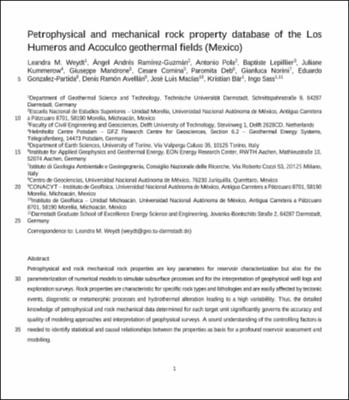| dc.contributor.author | Weydt, Leandra M. | |
| dc.contributor.author | Ramírez-Guzmán, Ángel Andrés | |
| dc.contributor.author | Pola, Antonio | |
| dc.contributor.author | Lepillier, Baptiste | |
| dc.contributor.author | Kummerow, Juliane | |
| dc.contributor.author | mandrone, giuseppe | |
| dc.contributor.author | COMINA, Cesare | |
| dc.contributor.author | DEB, PAROMITA | |
| dc.contributor.author | Norini, Gianluca | |
| dc.contributor.author | Gonzalez-Partida, Eduardo | |
| dc.contributor.author | Avellán, Denis-Ramón | |
| dc.contributor.author | Macías, José Luis | |
| dc.contributor.author | Bär, Kristian | |
| dc.contributor.author | Sass, Ingo | |
| dc.date.accessioned | 2020-12-11T07:08:30Z | |
| dc.date.available | 2020-06-03T11:20:16Z | |
| dc.date.available | 2020-06-03T11:59:34Z | |
| dc.date.available | 2020-11-11T11:48:40Z | |
| dc.date.available | 2020-11-11T20:18:48Z | |
| dc.date.available | 2020-12-11T07:08:30Z | |
| dc.date.issued | 2020-11-11 | |
| dc.identifier.uri | https://tudatalib.ulb.tu-darmstadt.de/handle/tudatalib/2340.10 | |
| dc.identifier.uri | https://doi.org/10.25534/tudatalib-201.10 | |
| dc.description | Petrophysical and rock mechanical properties are key parameters for the characterization of the deep subsurface in different disciplines such as geothermal heat extraction, petroleum reservoir engineering or mining, are commonly used for the interpretation of geophysical data and the parameterization of numerical models and as thus are the basis for economic reservoir assessment. However, detailed information regarding these properties for each target horizon are often scarce, inconsistent or spread over multiple publications. Thus, subsurface models are often populated with generalized or assumed values resulting in high uncertainty. Furthermore, diagenetic, metamorphic and hydrothermal processes significantly affect the physiochemical and mechanical properties often leading to high variability. A sound understanding of the controlling factors is needed to identify statistical and causal relationships between the properties as basis for a profound reservoir assessment and modelling.
Within the scope of the GEMex project (EU-H2020, GA Nr. 727550), which aims to develop new transferable exploration and exploitation approaches for super-hot unconventional geothermal systems, a new workflow was applied to overcome the gap of knowledge of the reservoir properties. Two caldera complexes located in the northeastern Trans Mexican Volcanic Belt - the Acoculco and Los Humeros caldera - were selected as demonstration sites. The Los Humeros geothermal system is steam dominated and has been exploited since the 1990’s with 65 wellbores (28 still producing). With temperatures above 380 °C, the system is characterized as a super-hot geothermal system. The geothermal system in Acoculco (presently consisting of two exploration wells) is characterized by temperatures of approximately 300 °C at a depth of about 2 km. It contains almost no fluids, even though a well-developed fracture network exists in the study area. Therefore, the system serves as a demonstration site for the development of an enhanced geothermal system.
The workflow starts with outcrop analogue and reservoir core sample studies in order to define and characterize the properties of all key units from the basement to the cap rock as well as their mineralogy and geochemistry. This allows the identification of geological heterogeneities on different scales (outcrop analysis, representative rock samples, thin sections and chemical analysis) enabling a profound reservoir property prediction.
More than 340 rock samples were taken from representative outcrops inside of the Los Humeros and Acoculco calderas, the surrounding areas and from exhumed ‘fossil systems’ in Las Minas and Zacatlán. Additionally, 66 core samples from 16 wells of the Los Humeros geothermal field were obtained. Samples were analyzed for particle and bulk density, porosity, permeability, thermal conductivity, thermal diffusivity, heat capacity, as well as ultra-sonic wave velocities, magnetic susceptibility and electric resistivity. Afterwards destructive rock mechanical tests (point load tests, uniaxial and triaxial tests) were conducted to determine tensile strength, uniaxial compressive strength, Young’s modulus, poisson ratio, bulk modulus, shear modulus, fracture toughness, cohesion and friction angle. In addition, XRD and XRF analyses were performed on 131 samples to provide information about the mineral assemblage, bulk geochemistry and the intensity of hydrothermal alteration.
An extensive rock property database was created comprising 34 parameters determined on more than 2160 plugs. More than 31,000 data points were compiled covering volcanic, sedimentary, metamorphic and igneous rocks from different ages (Jurassic to Holocene), thus facilitating a wide field of applications regarding resource assessment, modeling and statistical analyses. | en_US |
| dc.language.iso | en | en_US |
| dc.relation | IsSupplementTo;DOI;https://doi.org/10.5194/essd-2020-139 | |
| dc.rights | Creative Commons Attribution 4.0 | |
| dc.rights.uri | https://creativecommons.org/licenses/by/4.0/ | |
| dc.subject | Petrophysical Properties | en_US |
| dc.subject | Mechanical Properties | en_US |
| dc.subject | Outcrop Analogue Study | en_US |
| dc.subject | Reservoir Samples | en_US |
| dc.subject | GEMex project | en_US |
| dc.subject | Los Humeros | en_US |
| dc.subject | Acoculco | en_US |
| dc.subject | Super-Hot Geothermal Systems | en_US |
| dc.subject.classification | 315-01 Physik des Erdkörpers | |
| dc.subject.classification | 318-01 Hydrogeologie, Hydrologie, Limnologie, Siedlungswasserwirtschaft, Wasserchemie, Integrierte Wasser-Ressourcen Bewirtschaftung | |
| dc.subject.classification | 316-01 Mineralogie, Petrologie und Geochemie | |
| dc.subject.classification | 314-01 Geologie, Ingenieurgeologie, Paläontologie | |
| dc.subject.ddc | 624 | |
| dc.subject.ddc | 550 | |
| dc.title | Petrophysical and mechanical rock property database of the Los Humeros and Acoculco geothermal fields (Mexico) | en_US |
| dc.type | Dataset | en_US |
| dc.type | Text | en_US |
| dc.description.version | V1.2 | en_US |
| tud.unit | TUDa | |
| tud.history.classification | Version=2016-2020;314-01 Geologie, Ingenieurgeologie, Paläontologie;315-01 Physik des Erdkörpers;316-01 Organische und Anorganische Geochemie, Biogeochemie, Mineralogie, Petrologie, Kristallographie, Lagerstättenkunde;318-01 Hydrogeologie, Hydrologie, Limnologie, Siedlungswasserwirtschaft, Wasserchemie, Integrierte Wasser-Ressourcen Bewirtschaftung; | |


